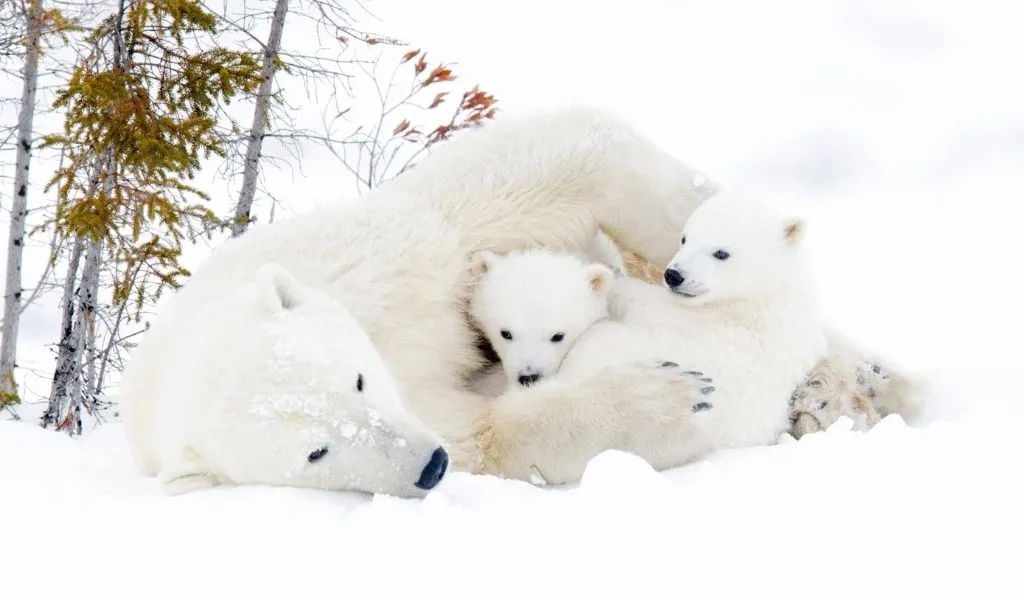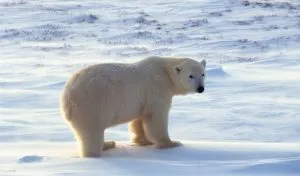The polar bear lives in some of the most extreme parts of the planet near the north pole. Temperatures can be below freezing for most of the year and access to food changes throughout the year. So, how do polar bears survive in the arctic?
Polar bears are well adapted to survive in the arctic climate. They have two layers of fur and fat for insulation, large paws to walk on the snow, and an excellent swimming ability. They can quickly build excess fat during winter which they can convert to energy to survive in the summer.
This is just the start of it. Keep reading for a full breakdown of the adaptations that help them survive the cold.
What Temperature Can Polar Bears Survive?
Polar bears live in the arctic which is the northernmost part of the world from the north pole and extending south. Typically, temperatures in the Arctic will vary from −37°C (−35°F) in the winter up to 10°C (50°F) in summer.
During the winter when there is lots of sea ice, they will utilize this for hunting seals, walrus, and other marine mammals.
When the sea ice melts for the summer, they will migrate to the mainland such as Alaska, Canada, Russia, Norway, and Greenland, or smaller groups of islands in the Arctic.
Polar bears are able to survive in temperatures between -45°C and 10°C (-50°F and 50°F).
How Do Polar Bears Survive in the Cold?
Polar bears are well adapted to survive in the cold weather of the arctic due to their huge size and insulation from excess fat and two layers of fur.
They are the biggest bear species. An adult male polar bear weighs 350-680kg (775-1500lbs) and can be up to 3m (10 feet) in size from their nose to tail.
Larger animals have a lower surface area to volume ratio which means they minimize heat loss1 (source: BBC). Females are smaller but still have an advantageous surface area for the cold.
Their outer layer of fur contains long, hollow hairs. The air between the hairs provides excellent insulation for polar bears. They are so well insulated against the cold, that they can risk overheating when they do physical activity, especially given their huge size. When they get too warm, they will dive into the cold ocean to cool off.
Polar bears are excellent swimmers, this is essential since the majority of a polar bear’s diet consists of seals which they catch in the water. They have partial webbing between their toes which helps with this.
However, their fur loses its insulative properties when submerged in water so polar bears don’t swim more than necessary, often taking longer routes than necessary to avoid getting in the water too often2 (source: Arctic Animals and Their Adaptations to Life on the Edge, A. S. Blix, 2005).
Polar bears have black skin (except for cubs). It is often claimed that their black skin is to absorb heat for thermal warming, however, studies have disproved this claim and it is still unknown why they have evolved to have black skin when most bears have pink skin3 (source: Polar Bears: A Complete Guide to Their Biology and Behavior, A. E. Derocher, 2012).
Adaptations of a Polar Bear
Let’s take a look at some of the main adaptations of polar bears that help them survive:
1. Their fur provides insulations and camouflage
Similar to other bears, polar bears have two layers of fur although theirs are well adapted to the Arctic:
- The bottom layer of fur is the undercoat, this is short, fine white hairs
- The top layer of fur is the guard hairs. These are longer and hollow. The trapped air provides two functions; it helps with insulation and provides extra buoyancy which is why polar bears can swim so well4 (source: Polar Bears, D. J. Tyler).
The two layers provide extra insulation for polar bears. Both layers of hair are translucent with black skin underneath, but despite this, they appear white. According to the WWF, this is because the translucent hairs reflect visible light which makes them look white.
This is another trait that helps them survive in the arctic as they remain well camouflaged. Although they don’t have any predators, it helps them sneak up on prey without being seen.
2. They can quickly build up body fat
Another adaption of polar bears is their ability to quickly build up their fat. These fat reserves serve two purposes; insulation from the cold and energy reserves for the summer months when they cannot access their usual diet of seals.
A large stomach capacity (around 10-20% of their body weight) and excellent digestion efficiency (they use 84% of protein and 97% of fat) allow polar bears to rapidly put on weight ahead of the summer5 (source: Polar Bear, M. Fee, 2019).
This fat is mainly concentrated around the base of their back and butt with little fat on their legs, neck, or head.
Seal blubber is very high in energy, so a small amount will make a large contribution to their fat. Polar bears will consume two thirds of their annual food intake between April and June6 (source: Polar Bear, M. Fee, 2019) and at their peak, they may weigh 50% more than at their minimum due to the extra fat storage7 (source: Polar Bears: A Complete Guide to Their Biology and Behavior, A. E. Derocher, 2012).
They can also use their fat to create metabolic water, this is essential given that they live in the arctic which is a polar desert and has little supply of freshwater8 (source: University of California, Berkley, R. Sanders, 2014). This is similar to how camels store water in their humps in a hot desert.
3. Their paws are adapted for walking on snow and swimming
polar bears have paws that are well adapted for the ice and snow they inhabit during the winter.
Their huge paws help distribute the load across the snow like giant snowshoes9 (source: BBC) and they are overgrown with hair which creates friction on the ice to keep warm.
The underside is rough like sandpaper, however, it is the claws that provide most of the traction10 (source: Polar Bears: A Complete Guide to Their Biology and Behavior, A. E. Derocher, 2012).
They have short, broad, and curved claws which are ideal when hunting slippery prey such as seals11 (source: Polar Bear, M. Fee, 2019). The slight webbing on their feet makes them excellent swimmers which also aids with hunting.
Other Adaptations of Polar Bears
Some of the other ways polar bears have evolved to survive the arctic climate are:
- Small tail and ears – Polar bears have a smaller tail and ears than other bear species. This is another tactic to reduce heat loss, helping the bear stay warmer.
- Excellent sense of smell – This allows them to smell other animals, including humans, up to 32km (20 miles) away12 (source: Polar Bears, S. Markle, 2004) or when they are hidden under the snow. There’s no need to worry though, polar bears don’t eat humans and will typically avoid them.
- Walking hibernation – Although polar bears do not hibernate, they can minimize the energy they use in summer by reducing their heart rate and temperature, this is often referred to as ‘walking hibernation. Although, they can quickly switch back to normal when they need to hunt prey13 (source: Polar Bears, D. J. Tyler).
- Long but thin head and neck – Over time, the polar bear’s skull has elongated. This helps them hunt seals through holes in the ice when they cannot get in the water14 (source: University of Notre Dame, A. Hellinghausen, 2019).
- Large canines and small molars – This is reflected in their teeth where they have huge canines which are typical of a carnivore and smaller molars when compared to other omnivorous bears15 (source: Polar Bear, M. Fee, 2019).
Related Questions
How Long Do Polar Bears Live?
Female polar bears have a lifespan of around 30 years whereas males will typically live for 25 years.
Do Polar Bears Have Predators?
No, polar bears do not have any natural predators other than humans. Although it is illegal to hunt polar bears in most Arctic countries, the rules often allow native people to hunt and eat polar bears. Although they tend to have quotas on the number they can kill each year as part of conservation efforts.
How Large Can Polar Bears Get?
Polar bears are the largest of bear species, although brown bears will rival their size in certain regions. The size of an adult polar bear is between 2.4-3m for males and 1.8-2.4m for a female. An adult male will weigh between 350-680kg whereas females are much lighter, weighing between 150-250kg.
Are Polar Bears Mammals?
Yes, polar bears are mammals. Whilst all other bear species are terrestrial mammals, polar bears are considered to be marine mammals because of their reliance on the sea ice for their survival and their diet of marine mammals16 (source: Oceana).
Some people confuse this for meaning that a polar bear lives in the water, however, they spend most of their time on land. A marine mammal does not necessarily have to live in the water but just relies on its ecosystem.
How Fast Are Polar Bears?
Polar bears can run up to 40 km/h (25 mph), although they can quickly overheat when they do too much physical activity so you will only find them reaching these speeds when they are chasing prey or protecting their young.
You will usually find them wandering slowly over the ice at around 5.5 km/h (3.4 mph)17 (source: Seaworld).




![Read more about the article How Do Polar Bears Reproduce? [Full Reproductive Cycle]](https://polarguidebook.com/wp-content/uploads/2021/09/how-do-polar-bears-reproduce-300x176.jpg)
![Read more about the article Can Polar Bears Climb Trees? [No – Here’s Why]](https://polarguidebook.com/wp-content/uploads/2021/09/Can-Polar-Bears-Climb-Trees-300x176.jpg)